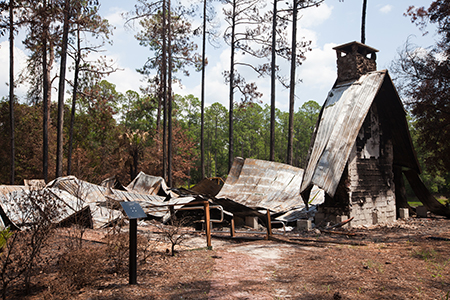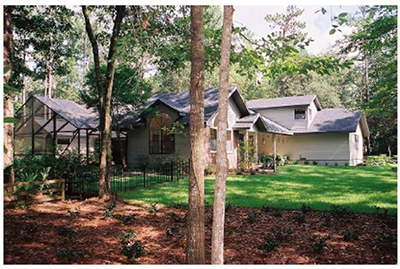Wildfire Risks
Drought can have a big impact on our plants and landscapes, but the damage a drought can cause is not limited to wilting lawns and dehydrated plants. Wildfires are much more common during periods of drought and pose a serious risk to homes and businesses. The concern is even more acute for Florida residents in less developed or rural areas.

Austin Cary Memorial Forest Conference Center after August 2011 fire.
UF/IFAS Photo by Dawn McKinstry.
When drought conditions exist, it's important to determine your home's risk, take actions to protect your home, and review safety and evacuation plans.
Two of the factors that contribute to the wildfire risk to your home are how the land is used or developed in your area coupled with the kind of vegetation surrounding your dwelling. Living in a subdivision surrounded by homes and lawns without nearby forests, or in an urban area, means it is unlikely a wildfire would reach your home. The majority of Floridians live in areas that are at low risk of wildfire.
However, if you live in a rural-urban interface area, have undeveloped or wooded land near your home, or even undeveloped land surrounding your subdivision, you could be at risk should a wildfire occur nearby. If you live in an area where wildfires are more of a concern, it's important to take steps to protect your home.
Protecting Your Home
An immediate action you can take to protect your home is to clear needles, leaves, and other debris from your roof, gutters, eaves, porch, and deck. Remember, dead leaves and pine needles can ignite from embers that are blown in from a nearby fire. In fact, studies have shown that embers are more likely to ignite homes and buildings than actual flames from a wildfire.
Plant low-flammability plants near your home, and keep any plants trimmed back so they don't touch your structure. Ideal shrubs include: agave, aloe, azalea, viburnum, hydrangea, oleander, philodendron, pittosporum, red yucca, beautyberry, camellia, century plant, coontie, anise, Indian hawthorn, and oakleaf hydrangea.
Reduce the use of mulch within 5 feet of your house and consider replacing it with hardscaping, rock, stone, or gravel.
Keep your lawn well irrigated as dry plants will catch fire more easily.
Flammable items, like firewood piles, portable propane tanks, and dry or dead vegetation should be kept at least 30 feet away from all structures.
Keep separation between the tops of shrubs and the bottom branches of trees. Fires generally move across the ground but can use shrubs or low-hanging tree limbs to climb higher. These "ladder" fuels can bring the fire closer to your home and create additional risks, especially if your house has flammable features or vulnerable openings.

These homeowners removed all the saw palmettos (a highly flammable plant) within 30 feet from the house. However, in other areas outside the defensible space, some palmettos were retained for their wildlife and aesthetic value.
Evaluating Your Home's Risk
You can look around your home and evaluate how risky conditions are in your area based on the surrounding vegetation.
Low Risk Conditions
- Bare ground, improved pasture, or widely spaced grassy clumps or plants
- Wet or humid forest, mostly leafy trees, or mostly large trees
- Few plants growing low to the ground
- Leaves on the ground are from oak trees or other broadleaf species
Medium Risk Conditions
- Thick, continuous grasses, weeds, or shrubs
- A continuous thin layer of pine needles and scattered pine trees
- Scattered palmettos or shrubs up to 3 feet tall separated by patches of grass or sand
- A clear view into or across the undeveloped area
High Risk Conditions
- A thick bed of pine needles and lots of pine trees
- Continuous palmettos, shrubs, or grasses more than 3 feet tall
- Vines and small-to-medium trees or palms beneath taller pine trees
- Impenetrable shrubs or young pines
- No clear view into the undeveloped area because of dense growth
Also on Gardening Solutions
UF/IFAS Publications
- Landscaping in Florida with Fire in Mind
- Wildfire Risk Assessment Guide for Homeowners in the Southern United States (PDF)

